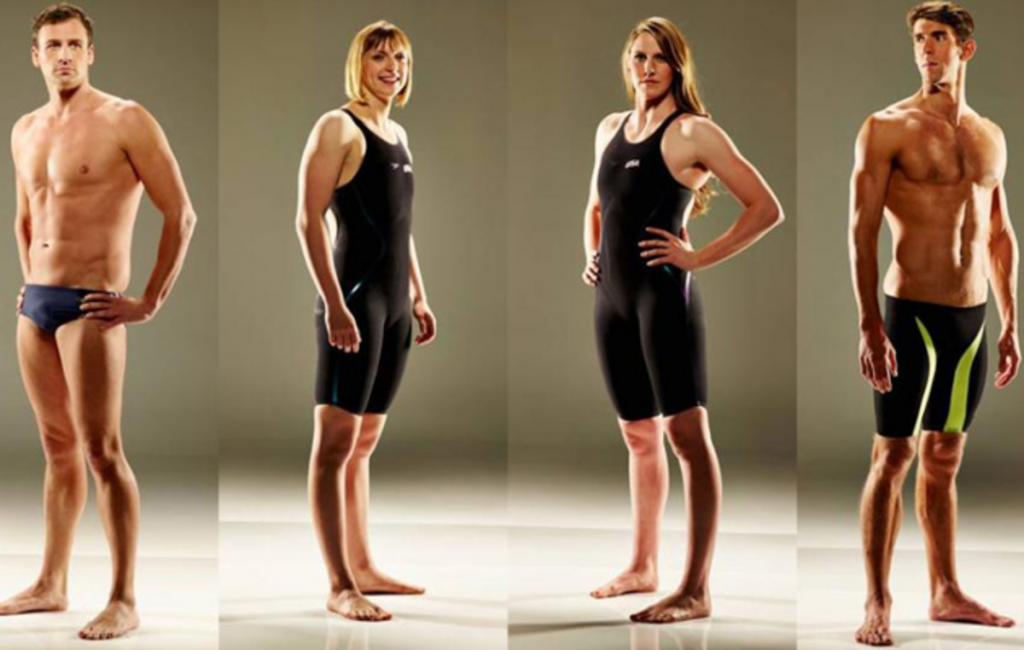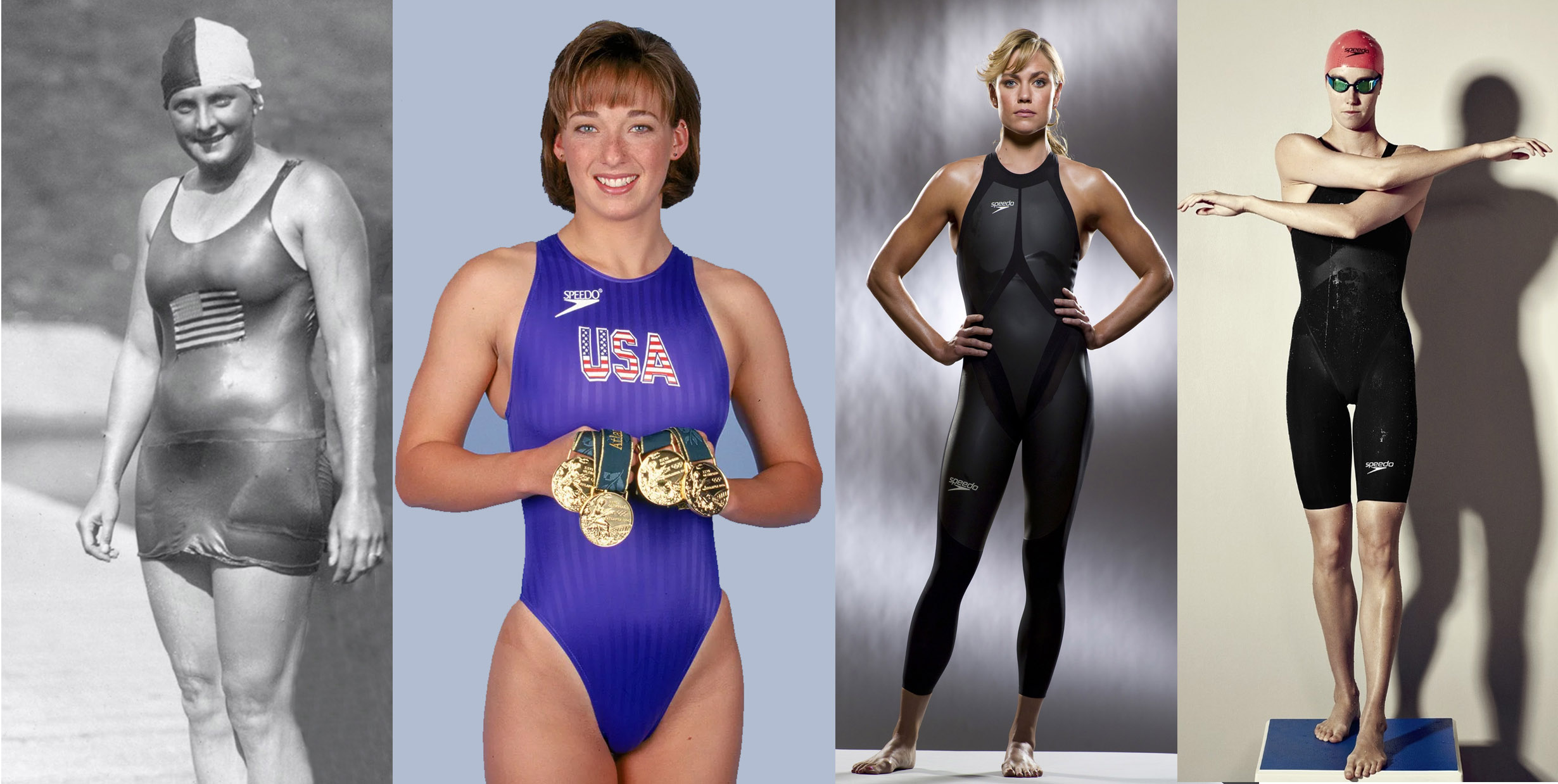Swimming suits were invented in the mid-1800s. Initially, women wore form-fitting outfits called tank suits, which were made of wool and extended to their necks and wrists.
Men also wore a similar bathing suits that reached down to their knees. In the early 1900s, swimsuits became more revealing as styles evolved with the fashion trends of the era.
Swimsuit History
For example, men began wearing trunks while women’s one-piece suits featured higher leg lines and lower necklines.
Bikinis first appeared on beaches in France in 1946, though they did not become widely accepted until much later.
Today, swimming suits are available in a variety of colors and styles – from string bikinis to full-body wetsuits – making them suitable for both recreational and competitive swimming.
Who invented the Swimsuit?
In the 19th century, swimsuits were generally made of wool and often featured long sleeves, a high neckline, and a knee-length skirt.
However, the first bathing suit designed specifically for swimming was created around the 1900-s by Australian swimmer and performer Annette Kellerman.

She had a great influence on fashion history when she debuted a one-piece swimsuit that showed her arms, legs, and neck.
Swimming for women has been influenced significantly by gender, stereotyping, bias, and “decency” laws.
Annette Kellerman was arrested in the USA for indecent exposure in 1907 because her swimsuit depicted her arms legs and neck when performing an “Underwater Ballerina”, in a glass menagerie, in an early demonstration of synchronized swimming.
In 1913, inspired by the introduction of female athletes into Olympic swimming events, designer Carl Jantzen made the first functional swimming suit, it was a close-fitting one-piece, which consisted of shorts on the bottom and a top with short sleeves.

Who invented the bikini swimsuit?
The first “bikini prototypes” consisted of two pieces, which were covered by a navel, and only a slender band of midriff was left exposed, this swimwear became very popular in the 1940s.
Pinups of Rita Hayworth and Esther Williams glamorized the pairing of high-waisted bottoms with generous halters.
The swimsuit apron disappeared by 1918, and since that time there was a tunic covering the shorts. Even though matching stockings were still worn, bare legs were exposed from the bottom of the trunks to the top of the shorts. On some beaches in the United States, men were prohibited from going topless as late as the 1930s.
Competitive Swimsuits Through History
It wasn’t until the Olympics in 1912 that freestyle for women was first allowed in the Olympic Games. Prior to this date, the founder, Baron Pierre de Coubertin had accepted the wrongly held Victorian belief that women were too frail to engage in competitive sports.

This fallacy was entirely destroyed when in 1926 Gertrude Ederle “did what was thought impossible for a woman” when she swam the English Channel and “ beat the best time by a man by over two hours (14hrs 39mins) ” proving “ to the world that women “had the stamina to participate in physically demanding activities” at “a level equal to men”.
She first tried to cross the English Channel in 1925 but didn’t make it till the finish.
During Ederle’s first attempt across the channel, she wore a heavy one-piece that was filled with water and chaffed her skin.
But on August 6, 1926, she arrived at the French end of the channel wearing a lighter two-piece she’d fashioned by cutting up a one-piece. “She was so slathered in grease and such that it was hardly recognizable,” Dahlberg notes.

By the 1920s, swimsuits featuring shorter hemlines and low-cut armholes became popular among both men and women.
In the 1920s-1940’s women started to wear swimsuits that were tighter around the waist and bust than previous designs had ever been, and they were accompanied by short skirts to preserve some modesty.
Whilst this was the most significant development swimwear had seen, women were still bound by the requirement of a minimum skirt length, and authorities made sure this was enforced by monitoring and fining women who disobeyed.
The history of competitive swimwear has been dominated by concerns over public nudity in the first half of the 20th century and by efforts to reduce water drag in the second half.
Those efforts initially led swimmers to reduce the early sagging one-piece swimsuits down to briefs only.
With the development of new materials that tightly fit the body and offered lower resistance to water than human skin, this trend was reversed to a complete body coverage from heels to neck and wrists.
Competitive Swimwear Evolution
While men’s swimming events were a part of the Olympics, women’s races were included in the program only in 1912, but until 1924 were limited to a couple of freestyle events.
Public nudity was a problem and therefore was a major concern in designing swimwear.
It was one of the reasons why the American women’s team did not participate in the 1912 Olympics. At those Games British women wore full-body swimsuits made of silk, their size and body coverage was revolutionary.

They wore briefs and bras underneath, but the suits became transparent when wet. It was a very sensitive topic at that time and women’s teams were even accompanied by chaperones to prevent any possible harassment.

During the 1920s the swimwear market developed rapidly, mainly due to the acceptance of swimming as an international sport and a more liberal social attitude towards mixed bathing.
In 1928 Australian MacRae company introduced the classic, figure-hugging “Racerback” costume, which provided more comfort and freedom of movement, letting athletes swim faster.
This inspired staff member Captain Parsons to create the slogan ‘Speed on in your Speedos’ and the Speedo brand name was born in 1928.

In 1929 the first Speedo swimsuits were produced. The newly-named brand soon established itself in the hearts and minds of the swimmers and the general public, thanks in part to Swedish swimmer Arne Borg, who set a world record in Speedo swimwear.
Despite all the revolutionary ideas the path of sports swimsuits was far from being obstacle-free.
Uncovered shoulders were remaining something scandalous and it almost led to the disqualification of Clare Dennis at the 1932 Olympics, but soon became a standard.
Meanwhile, men were allowed to swim in bare-chest suits in 1936, and in briefs only at the 1948 Olympics.
Competitive Swimsuit Fabrics
In 1956, Speedo became the first company to introduce nylon, and in the 1970s elastane to their swimsuits, dramatically improved their elasticity, and durability and helped to significantly reduce the water drag – 21 out of 22 records at the 1972 Olympics were broken using nylon/elastane suits.
As early as the Munich Olympics the East German women had shown up in skintight, high-neck swimsuits that in or out of the water made them resemble sleek wet seals. The suits were initially made of cotton and became virtually transparent when wet. The revealing shape and transparency caused outrage among US swimmers.

The revolution had been taking shape for quite some time, but it wasn’t until the black week at Belgrade last September 1973 that the swimming world began to pay serious notice.
The East German women so solidly whomped their U.S. counterparts at the World Aquatic Games in Yugoslavia, winning 10 of 14 events and setting seven world records, that puzzled experts began looking about for the reasons. And the more they looked, to put it plainly, the more obvious the answer became.
Those races and events became the turning point for the competitive swimming world to adopt the skinsuit, made of progressive synthetic materials, as a standard competitive swimwear.
Speedo Fastskin and LZR Racer Swimsuits
Speedo launched the Fastskin suit series in 2000, these suits mimicked shark skin. The surface of the material contained bumps and ridges that channeled the water over the athlete’s body appx. 3% more efficiently than traditional materials.

Those Fastskin suits covered the body from neck to ankles and wrists. Their design and shape were optimized for specific swimming strokes, compressing some body parts while allowing more freedom to the others.
Those suits got FINA approval for the 2000 Olympics, and swimmers who wore these suits won 83% of the medals.
FINA Swimsuit Ban
In 2008, Speedo launched a new model, the LZR Racer swimsuit produced of woven elastane-nylon and polyurethane (50%). LZR Racer provided better oxygen flow to the muscles, and hold swimmer’s body in a more hydrodynamic position, while repelling water and increasing flexibility. The seams of the suit were ultrasonically welded to further reduce water drag.

Following the LZR Racer steps, alternative non-textile suits have been introduced by other brands. Some of them, for example, the Arena X-Glide, Jaked01, and Adidas Hydrofoil were entirely made of polyurethane. By the summer of 2009, more than 130 world records had been broken by swimmers wearing non-textile suits, and more than 90 of them were set with the LZR Racer.
In July 2009 FINA changed the regulations and banned all body-length swimsuits.
FINA banned full-body suits from competition effective from 1 January 2010, stating that it “wishes to recall the main and core principle is that swimming is a sport essentially based on the physical performance of the athlete”.
The new policy states that men’s swimsuits may maximally cover the area from the waist to the knee, and women’s counterparts from the shoulder to the knee.

FINA also stated that the fabric used must be a textile or a woven material and that a suit may not have any fastening devices such as a zipper (drawstrings on male jammers are allowed).
The textile was defined as any open-mesh natural or synthetic material like cotton, Nylon, Lycra, etc. The new regulations took effect on 1 January 2010, but the previous records set in non-textile suits remain valid.
Although the story of swimwear evolution might not be very long, it is certainly full of milestones and radical turns.


Leave a Reply